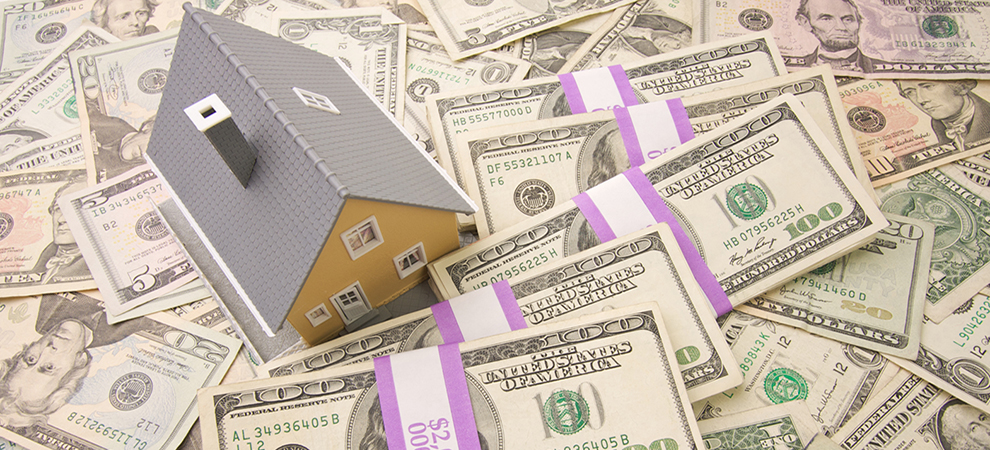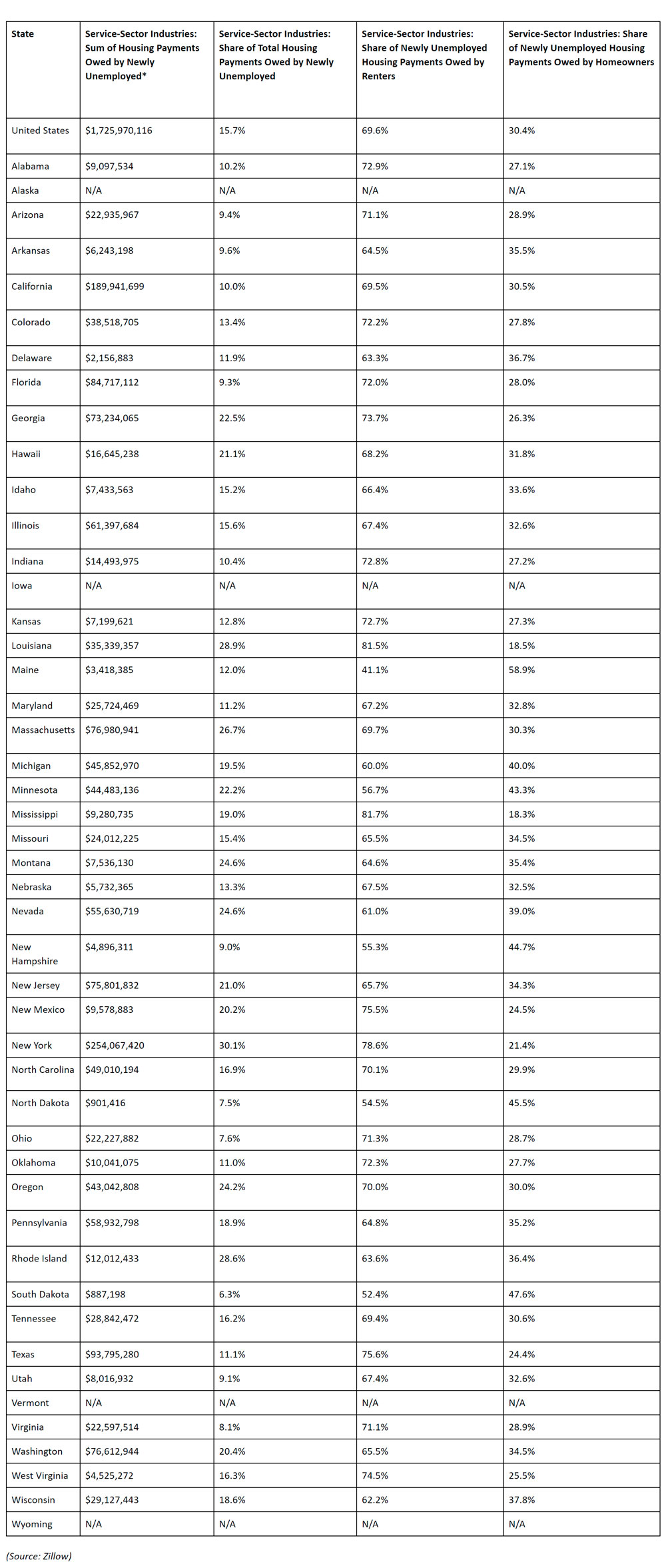The WPJ
THE WORLD PROPERTY JOURNALReal Estate Facts Not Fiction
Residential Real Estate News

$1.7 Billion a Month in Housing Payments Owed by Newly Unemployed Service Workers in U.S.
Residential News » Seattle Edition | By Michael Gerrity | June 15, 2020 9:06 AM ET
Federal and state aid is helping to plug gaps in the short term
Zillow is reporting this week that more than $1.7 billion in housing rents and mortgage payments is owed each month by U.S. service-sector workers currently receiving unemployment benefits as a result of the coronavirus pandemic -- payments that could be in jeopardy if expanded local and federal unemployment assistance fades or workers remain without incomes longer than expected.
Service-sector workers (including the food, arts, entertainment, recreation and retail industries) are perhaps feeling the greatest financial impact from COVID-19 as many shops and restaurants reduced operations or shut their doors completely. An estimated $1.7 billion in rent and mortgage payments is owed each month by service-sector workers who received unemployment benefits in April as a result of COVID-19, according to a new Zillow analysis.
About 70% of that total ($1.2 billion) is from renters, illustrating the unprecedented scale of what is at risk in the rental market. That's nearly 3% of the total monthly rent paid in the U.S., even before accounting for newly unemployed renters in all other industries -- Zillow estimates service-sector workers comprise a little more than a third of those who have lost their jobs as a result of the coronavirus pandemic. Previous Zillow research has shown renters in the food and retail industries already struggled with cost burdens before the pandemic, making it difficult for those who fall behind to catch back up.
"As we're watching resilient buyers return to the for-sale market and more renters able to pay on time in May than in April, it's important to remember that much of the confidence that led to that improvement rests on massive government aid," said Zillow Senior Principal Economist Skylar Olsen. "By supporting the more than 40 million Americans who have filed for unemployment benefits, that package is not only easing financial hardships but also safeguarding the housing market from widespread evictions and foreclosures that could have devastating effects. That safety net has an end date, so if employment does not bounce back as hoped this summer the housing recovery could be impeded, especially for renters who aren't insulated by the equity owners hold in their homes."
Safety nets including unemployment benefits, the CARES Act stimulus checks and temporary renter protections have eased tensions for many households for the short-term, at least. But with state reserves stretched, stimulus checks covering only a portion of the typical monthly rent or mortgage payment in many states, and many workers who don't qualify for benefits, a large share of housing payments could be missed eventually if government assistance expires or jobs don't return to pre-pandemic levels -- likely pushing some into housing insecurity.
Skyrocketing unemployment caused about 22% of renters to not pay any of their rent during the first week of April, up from about 18% last spring. That fell to 20% in May, a possible signal that government aid and the reopening of some businesses is helping to lessen financial stress. More assistance could be on the way in the form of the HEROES Act, but the long-term picture is unclear.
It's not only service-sector workers that are experiencing mass unemployment during the coronavirus pandemic. Some states with economies reliant on manufacturing are also feeling the impact of heavy unemployment. In Ohio, where manufacturing makes up the largest share of the state's GDP, 53% of housing payments owed by manufacturing workers are from those whose jobs have been affected by COVID-19. In Michigan, that share is 27%.
Even workers in essential industries that have been largely allowed to continue operations are not immune from unemployment. Many states halted non-emergency medical procedures, such as dental work and routine medical checkups, pushing some healthcare workers to file for unemployment benefits. In both Washington and Oregon, two states among the first to issue stay-at-home orders and limit business operations, healthcare workers receiving unemployment payments made up about 12.5% of the total housing payments owed by workers in that industry in April. That share is even higher in Georgia (19%), Rhode Island (18%) and New Hampshire (13.5%).
Sign Up Free | The WPJ Weekly Newsletter
Relevant real estate news.
Actionable market intelligence.
Right to your inbox every week.
Real Estate Listings Showcase
Related News Stories
Residential Real Estate Headlines
- U.S. New-Home Sales Surge in August as Mortgage Rates Ease
- Despite Increased Foreign Buyer Activity, Miami Residential Sales Dip 11 Percent in August
- California Home Sales Enjoy Modest Uptick as Mortgage Rates Ease
- U.S. Home-Flipping Profits Sink to Lowest Level Since 2008 Financial Crisis as Costs Climb
- Why the World's Rich Are Flocking to Europe in 2025
- Federal Reserve Delivers First Rate Cut of 2025 as Mortgage Relief Proves Limited
- Homebuilder Sentiment Holds Steady in U.S. as Rate-Cut Bets Lift Outlook
- U.S. Mortgage Rates Experience Sharpest Weekly Drop in Over a Year
- U.S. Foreclosures Rise for Sixth Straight Month as Affordability Pressures Mount
- Black U.S. Homeownership Rate Falls to Two-Year Low as Job Losses Mount
- Las Vegas Home Prices Flatten as Listings Surge, Sales Slow
- Cooling Miami Housing Market Sees 16 Percent Annual Sales Drop in July
- U.S. Mortgage Delinquencies Uptick in June Amid Regional Pressures
- California, Florida Top U.S. Housing Markets Most at Risk of Downturn
- 30-Year Mortgage Drops to 6.56 Percent in Late August, Lowest Since October 2024
- Investors Maintain Elevated Role in U.S. Housing Market Despite Slight Pullback
- Pending Home Sales Show Mixed Signals as U.S. Buyers Remain Cautious
- Canadian Home Sales Extend Recovery in July
- U.S. Home Sales Rise in July as Buyers Gain More Bargaining Power
- Zombie Foreclosures Edge Up Across U.S.
- 2.6 Million Homes at Wildfire Risk Across 14 Western States in 2025
- One in Five Americans Willing to Trade Personal Safety for Home Affordability
- U.S. Home Price Growth Slows as Affordability Pressures Mount in 2025
- U.S. Mortgage Rates Dip to Four Month Low in Early August
- U.S. Mortgage Applications Rise in Late July, Breaking Four-Week Slump
- Hong Kong's Housing Market Stuck in Stalemate as Bulls and Bears Face Off
- U.S. Condo Market Struggles in 2025
- U.S. Pending Home Sales Remain Sluggish in June
- Los Angeles Area Wildfires Destroyed Nearly $52 Billion in Homes Last January
- Greater Palm Beach Area Residential Sales Slip in June Amid Growing Inventory
- Economic Resilience Lifts U.S. Housing Outlook Going Forward
- New Home Sales Stagnate as Affordability Struggles Continue in America
- U.S. Housing Market Slips in June as Prices Hit New Highs
- Florida, California Continue to Reign Supreme as America's Ultraluxury Housing Markets
- Caribbean Housing Market Evolves into Global Second-Home Hotspot
- U.S. Home Sales See Highest June Cancellation Rate on Record
- Orlando Housing Market Cools in June as Listings Slide, Sales Slow
- Private Credit Surges in 2025 as Real Estate Developers Bypass Banks
- U.S. Condo Market Suffers Sharpest Price Drops in Over a Decade as Buyers Retreat
- Rising Taxes, Insurance Costs Undermine the Stability of U.S. Homeownership
Reader Poll
Marketplace Links
This website uses cookies to improve user experience. By using our website you consent in accordance with our Cookie Policy. Read More








